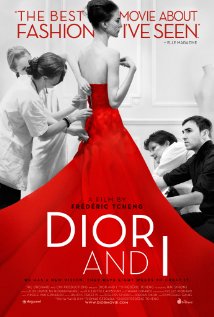
DIOR AND I
France, 2014, 90 minutes, Colour.
Raf Simons, Pieter Mulier, Sidney Toledano, Anna Wintour, Mariel Cottillard, Sharon Stone, Jennifer Lawrence, Harvey Weinstein and all the staff at Dior, behind the scenes.
Directed by Frederic Tcheng.
In recent years there have been documentaries and feature films about couturier, Yves St Laurent, highlighting his work and achievement in fashion as well as a great deal of detail about his personal life. Audiences should not expect this kind of treatment or revelations in Dior and I, even though it is based on book he wrote.
At the beginning, there is voice-over with a quotation from Christian Dior declaring that there were two of him. One was his real self (born 1905), the other being his public self (starting his work at the age of 41 in 1947). Apart from some tributes to him for his work and vision, some photographs from the 1940s and 1950s, and a visit to his family home, swimming in by helicopter, that is about all we discover about Dior himself.
So, this documentary is set in the present, introducing us to Belgian Raf Simons, the man chosen to be the contemporary designer for the company (2013) which is still flourishing, has its shop in Paris as well is its offices and its ateliers. Simons had been working in men’s fashion for 10 years with a reputation of being a minimalist, which he rather plays down. His new assistant is, another Belgian, Pieter Mulier.
Then we go behind the scenes and spend most of the film there, especially in the two ateliers with their extensive staff. in fact, we get something of the main designers, their sensibilities, their business sense, the pressure on them to achieve. And there are quite a number of interviews with some of the dressmakers, men and women, and a number of the seamstresses who have worked a long time for the company, one for 39 years. Most of the time, there are some genial human behind the scenes.
However, most of the attention is given to Simons himself, a middle-aged man, always wearing black, quietly authoritative, perceived at times as authoritarian, feeling the pressure of his work and his first show in the Dior tradition. We see him relating to the staff, approving designs, changing them, selecting materials, adapting the dresses as they are in progress, feeling the pressure of time, of the demands of clients in New York, choosing a mansion for the show, making a decision to cover the walls with flowers, with the logistics of how this can be done as well as keeping the flowers fresh.
We see Pieter Mulier and his liaising with the staff, supporting Simons. And then there is the show, the choosing of models, the fittings, the walk, plans for filming, the photographs, the interviews, focusing on greeting the guests (amongst whom Marion Cotillard, Sharon Stone, Jennifer Lawrence, Harvey Weinstein and, even, editor Anna Wintour), hugs and kisses, with Simons finally following the models onto the catwalk, cheerful, congratulated, a sense of achievement.
For those not up to date on fashion and/or ignorant of the amount of attention in detail it has to go into the design and the making, even down to stitching hems, There is something to learn about fashion. For those who are up-to-date and delight in colour, design, the range of dresses, plenty of satisfaction!